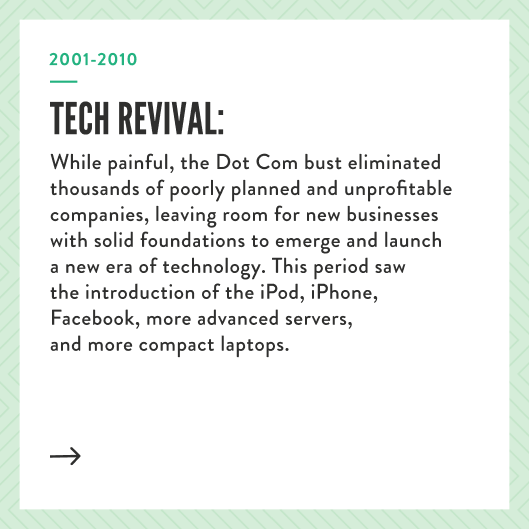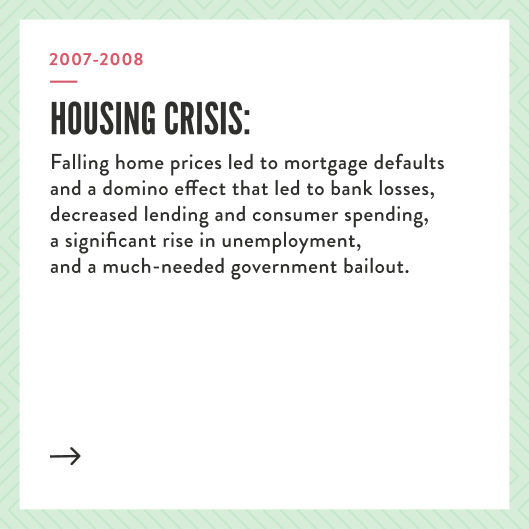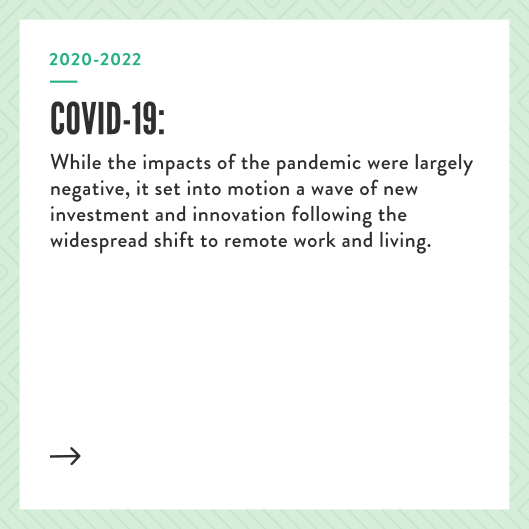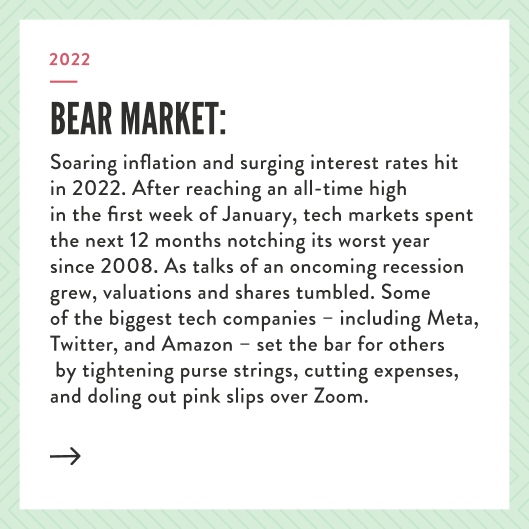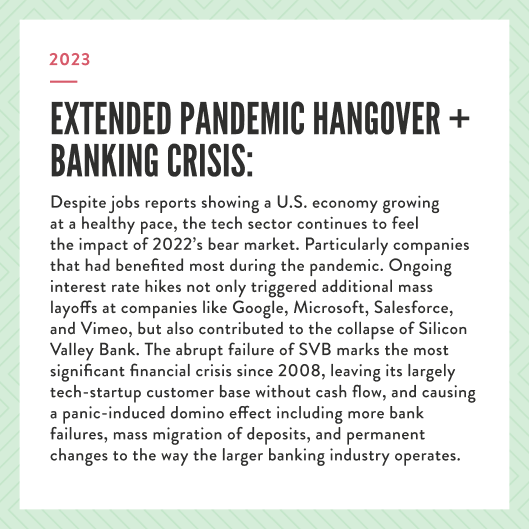There’s no denying disruptive shifts in the tech industry and larger economy – you can’t prevent them and certainly can’t predict them. But you can adapt your communications strategy to work with them. Downturns are an opportunity to stand out – to double down on the value you bring to customers, to act as a thought leader in a time of uncertainty, and to come out as a stronger brand on the other side of this.
Through the good times and the bad, your marketing communications program is one of the most effective tools for connecting with your audience, driving leads, and building future business health. While it might seem counterintuitive to dedicate energy and budget to marketing communications while scaling back costs during a downturn, it could be the time when an effective communications strategy matters most.
No two recessions are alike, which is why it is always challenging to know how to respond as marketers. Just look at the last 20+ years in tech:
A common thread among companies that have weathered stormy and sunny periods alike is an unwavering focus on marketing and communications. Consistent and relevant messaging engages existing and new audiences, builds brand reputation, and demonstrates market leadership. Instead of scaling back communications and marketing, focus on adjusting your program’s strategies to better leverage the conditions you’re facing.
DON’T GO DARK IN A DOWNTURN
When a significant shift impacts you and your customers, the worst thing you can do is go dark. Silence often breeds misinformation and panic. Instead, maintain contact, and provide open, honest, and regular communication with your stakeholders.
- Implement your crisis comms plan (if you have one) — If you don’t have a plan, quickly gather your communications, risk management, and employer brand teams together to run a risk analysis on all issues that could potentially impact your brand. Then align with your executive stakeholders on those findings and develop a triage-style crisis plan.
- Be a resource to your audience — Consider how you can be uniquely helpful. Ask how your brand can provide the best information and guidance to your customers and prospective customers.
- Monitor conversations — Expect your audiences to keep tabs on the situation and trust that they will talk to each other. Keep an eye on the media, article comments, and conversations happening on social media to better understand how key groups are reacting and what messages might resonate most.
SHIFT STRATEGY, SCOPE, AND MESSAGE
In a downturn, business goals and mindsets shift rapidly. To provide maximum value for your marketing communications dollar, quickly evaluate and adjust your strategy, message, and mix of tactics to meet your audience where they are and where you can drive short-term value and long-term brand advantage. Prepare your team to look at the old program with a critical eye and the lens of the current market pressures. To get you started, we’ve outlined our recommendations for adjusting different parts of your program to fit these priorities.
BRAND STRATEGY
- Audience Understanding – With large shifts, your audience’s needs and priorities will change. Set aside time to update your customer personas with intel on their new mindset and priorities to inform your teams on how to reach them best.
- Messaging – Use your updated personas to think through how you might revise your messaging. How can you better tailor your value prop and brand narrative to match your audiences’ new priorities?
- Crisis Comms Plan – To ensure you’re not scrambling to figure out your next steps when something happens, we recommend proactively building a fully executable crisis comms. Then, if and when the time comes, you will have a strategy you can confidently turn to, allowing you to act quickly and get back to business as usual. Your crisis comms plan shouldn’t gather dust in a drawer. Instead, treat it as a living document, updating it with learnings from each issue faced and as external factors evolve.
CONTENT CREATION
- SEO Strategy – How will your audience’s search queries change considering the economic environment? Think through where it makes sense for your brand to show up in their current customer journey and update your keyword strategy accordingly.
- Content Marketing + Sales Enablement – Focus on building assets that drive interest from your audience and aid the sales team in proving your value against competitors to close the deal. At the same time, arm your customer success team with what they need to maintain and grow current customer relationships. That might sound like a lot to ask of your content. But many pieces can work double time across multiple needs, such as informative blog posts, data-driven reports and e-books, audience personas, battle cards, product one-pagers, and results (case studies, stats, testimonials).
- Recycle Old Content – Chances are, you’ve already created a lot of great content; it’s just out of date or buried in the archives. Save time you might have otherwise spent writing net new content by reviewing your library for evergreen pieces to easily refresh and republish or ones that can be piecemealed (pulled apart, combined with others) to create additional posts. For instance, you can flip part of a blog into a download, bundle key points from multiple posts under a theme, or break up larger gated content into multiple ungated blog posts.
- Premium Content Assets – Building larger pieces of premium content like reports, white papers, and e-books may take more time upfront, but they pay off in the long run. Recycle large content assets to produce additional, smaller content that efficiently fuels activities across your entire program. Align the subject matter of your premium content with your revised narratives and messaging to deliver targeted communications to your audiences across channels.
- Gated Content – Mix in more gated content to capture additional leads. Remember that gated content doesn’t need to be a premium asset. Think about what small-scale downloads you can easily create, like infographics, lists, and one-pagers. In addition to publishing them on their own, look back through your existing blogs for places where it makes sense to insert them as an in-line download. Additionally, try to add them to posts already driving a decent amount of organic traffic.
- Incorporate AI — While an overreliance on AI for content marketing can rob assets of the originality they need to be thought-provoking, tools like ChatGPT can serve as a helpful assistant in your workflow. From ideation to outline development to copy editing, ChatGPT can deliver greater efficiencies that give your team more time to dedicate to creative and critical thinking.
PR & MEDIA RELATIONS
- Thought Leadership + Proactive Media Relations – Economic disruptions and market downturns are notorious for slowing down product roadmaps and announcement pipelines. To fill in the gaps left by a lack of hard news items, focus on proactive media relations strategies like newsjacking and angles fueled by original data.
DIGITAL MARKETING
- Ad Spend + Paid Search – A recession can be one of the best times to double down on ad spend to drive visibility and traffic to your website. As rates drop due to lower demand, you will get more bang for your buck and see a greater opportunity to grow your share of voice as many competitors cut back on spending. This will also boost brand image since active ads are often considered a sign of corporate stability.
EMPLOYER BRANDING
- Employee Communications – Don’t forget that your current workforce is one of your most important audiences. Economic changes can be a major source of stress for employees, especially if they feel like they aren’t getting the transparency they need from their employer to feel comfortable and informed. Prioritize your internal communications strategies to help retain talent, strengthen alignment on brand values, and generate a greater sense of belonging and community in your workplace.
- Hiring – It’s natural for layoffs to happen when the economic outlook is negative. No one likes to see it, but if you are in a position to hire, it can be a great time to acquire talent. If you’re in this boat, work with your communications team to build an employer branding strategy, including recruitment campaigns that sync with shifting employee expectations in the market. This is particularly important following events like the great reshuffling and the talent shortages we’ve seen in recent years.
STAY AGILE WITH YOUR COMMUNICATIONS
As you analyze your unique program and audience, remember that there is no specific playbook for navigating the inevitable ups and downs that will come your way. The most important strategy for achieving longevity is to avoid growing too attached to a particular scope of work. Instead, maintain a flexible program that focuses on the activities that make the most sense for your current business environment and priorities.

